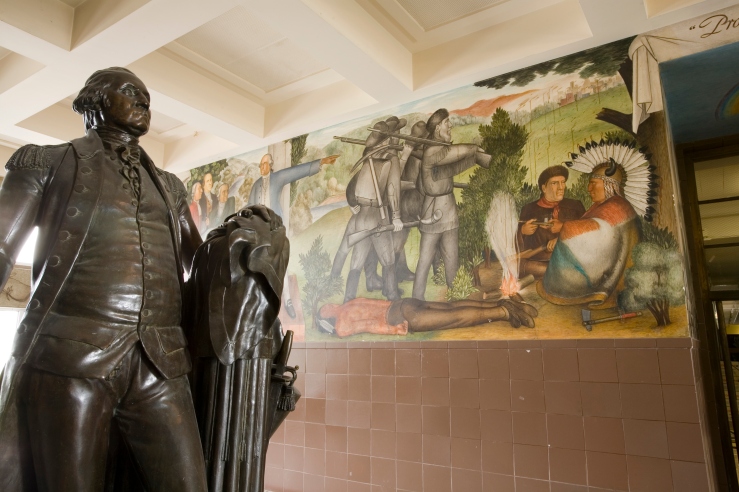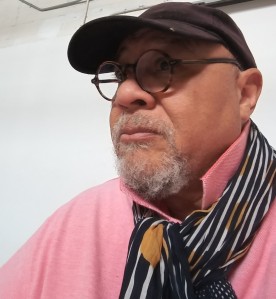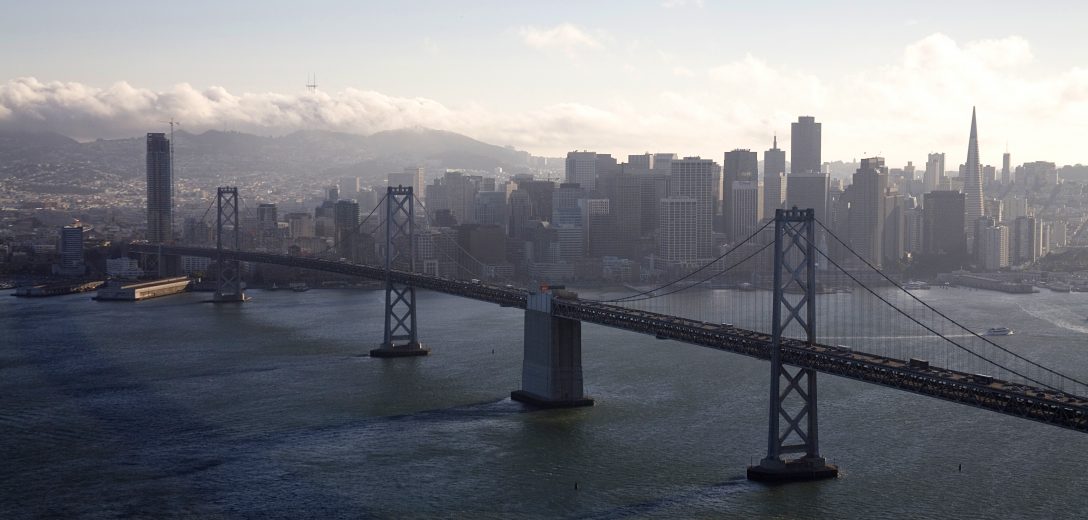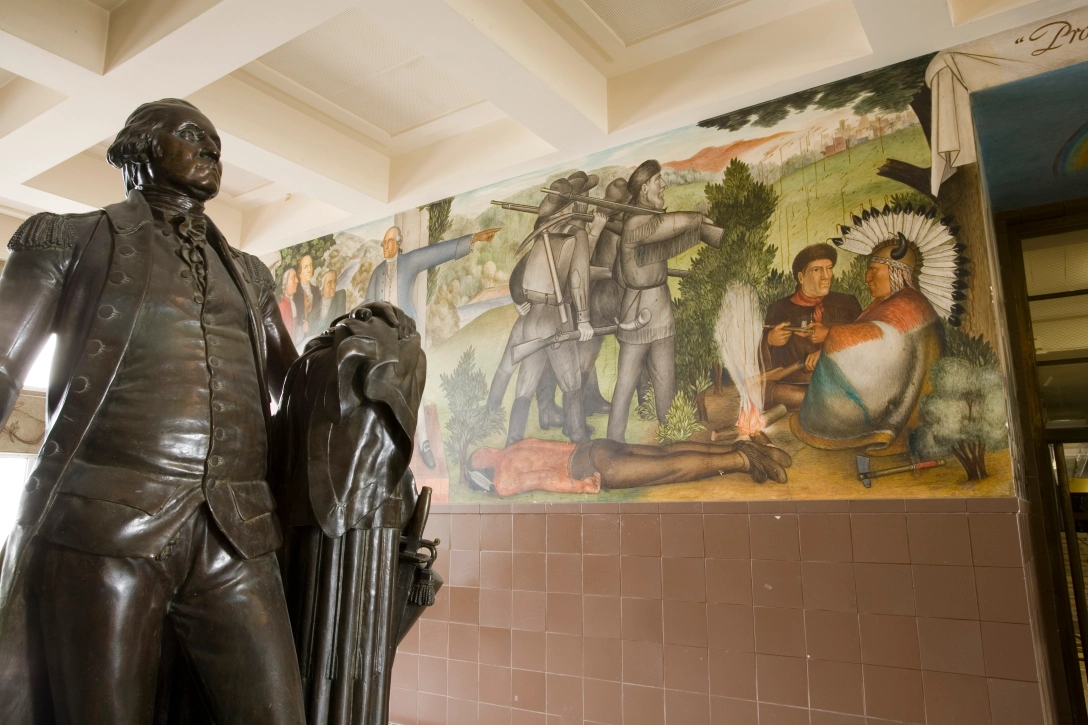
A debate is raging in art, history and education worlds over the fate of one of the largest installations of New Deal era-funded murals in San Francisco.
Artist Dewey Crumpler, now an associate professor at the San Francisco Art Institute, has seen this controversy before. He was once part of the solution.
In the turbulence of the late 1960s civil rights movement, Crumpler, who had just graduated from Balboa High School, was asked by a group of African American students at George Washington to paint more empowering murals at the school. The Black Students Union originally wanted the murals – painted in the mid 1930s on the walls of George Washington High School by Russian artist Victor Arnautoff – destroyed because of their derogatory and negative depictions of African Americans and Native Americans.
Arnautoff worked long hours on the fresh plaster of the hallways of the school during its construction from 1935 to 1936 with two assistants, painting 12 panels, or about 1600 square feet of frescoes. He was hired by local architect Timothy Pflueger, who just a few years earlier had been the brunt of criticism for hiring Mexican muralist Diego Rivera, to paint a mural for the San Francisco Stock Exchange Luncheon Club. Pflueger never backed down and continued to hire other left-leaning artists who worked in Rivera’s style for later projects such as George Washington High, including Ralph Stackpole and Lucien Labaudt, for murals in the library, and Sargent Johnson for the sculpted frieze on the athletic field. All these works were funded by the Federal Arts Project or the Public Works Administration under Franklin D. Roosevelt’s New Deal programs.
Arnautoff’s murals tell the story of the life of George Washington, the first president of the U.S. But Arnautoff, an émigré from Russia and a student and friend of Rivera, painted an unflinching view of Washington, especially for the 1930s. There are no story-book tales and Arnautoff’s view of America as a leftist and Communist, was radical in its time.
Instead of mythical cherry trees, Arnautoff’s murals depict a dead Native American lying face down on the ground as colonists, portrayed in grey, black and white, march past, in a grim and uncomfortable portrayal of the westward expansion of the young nation. Two other panels show African Americans working in the fields at Washington’s home in Mount Vernon. In the foreground of “Mount Vernon,” an overseer appears to be showing Washington what tasks his slaves are working on, while women work in the fields in the background. Other African Americans are working in the tougher, more physically strenuous jobs.

“The imagery was derogatory,” Crumpler said in a recent phone interview. “In the sense that even though Arnautoff was attempting to use it to address the contradiction in the founding father – you know owning slaves, and having trodded over the native American – under no circumstances should that kind of imagery be the primary imagery that students be confronted with when they needed equally empowering imagery.”
“That was my stance. But I explained that I did not believe that history should be whitewashed or that artists or artists’ work should be destroyed or censored, because it was a teaching tool. If you had the original source and a counter source, you could use that as a way of dialoguing about the controversy and the contradictions.”
The students wanted the murals destroyed, covered up or painted over. Ruth Adams, then the principal of George Washington suggested getting Arnautoff, who was still alive, to come back and add to his murals. But he had retired from his position at Stanford University three years previously and had repatriated to the then Soviet Union, where he was settled in a painting studio in the Ukraine near the sea.
By the fall of 1968, nothing had been done and in an era where students were protesting around the world, about 250 students at George Washington marched in the hallways one day in October, shouting “Take it down, take it down.” The murals were briefly covered up with butcher paper by school officials.
“Blacks did more than just pick cotton,” Black Student Union President Roosevelt Thomas said at a meeting soon after between school officials, students, parents and artists, according to the San Francisco Chronicle. “During the revolution, more than 5000 blacks fought for this nation’s independence. They’re not depicted in this mural.” Thomas, who was also a member of the Black Panthers, received a standing ovation for his remarks.
Thomas was referring to another mural in which Arnautoff painted some of the memorable moments of the American Revolution, including the Boston Massacre.

The students voted to keep the murals but they came up with a proposal to install plaques with more information alongside the murals. A group was formed to study the need for a new mural depicting events in black history.
That’s where Crumpler came in, as the artist the students selected to paint additional murals. He had sold a piece to Smokey Robinson which got him some attention with the students. But he faced some opposition from the San Francisco Arts Commission and the Board of Education because he was so young. Then, an unknown student threw ink on the Native American in the “Westward Expansion” mural, which got soaked into the plaster, and the school realized it had to do something.
“At that point, they really were nervous because they wanted to protect Arnautoff’s murals because of their historic value,” Crumpler said. So in early 1970, he was hired, but in one of his meetings with the students, he made it clear that he did not want Arnautoff’s murals destroyed. “I said I will make these murals on the condition that removing his is over with,” he said. The students agreed and they had a deal.
In researching murals to begin his work, Crumpler realized he needed to go to Mexico, to see the work of the master muralists, and to learn more about their techniques. He visited and studied murals all around the country, including many by Rivera, and met briefly with David Alfaro Siqueiros, who was still alive. He also got advice from Pablo O’Higgins, who had worked as Rivera’s assistant on three of his most important murals. In Mexico, he learned about scale and how the mural is integral to its location.
“It happened over a five year period,” he said. “When it started I had just graduated from high school and when it ended I had just graduated from graduate school… It was a long process because of the politics.”
Crumpler painted three murals in another location at the school, all facing each other in a U-shaped area, above student bulletin boards and school photos. The students got involved in developing the theme for the murals, and they decided to widen the focus beyond African Americans and Native Americans to include other races, including Latino and Asian students. In a statement about the story behind the mural, written in 1974, Crumpler noted that a number of students provide historical and pictoral accounts of figures that played roles in the developing of various cultures.
In April, 1974, Crumpler’s three murals were unveiled.


The center mural, called the Black Panel, has two men in the center, representing the spirit of African Americans, and how their strength and determination break the chain of bondage. Also pictured in the mural are two of the most inspirational leaders in the late 1960s, Malcolm X and Dr. Martin Luther King and other prominent figures, from Frederick Douglas to Langston Hughes.
In the Asian panel on the right, two children form the Yin and Yang symbols, with local artist Ruth Asawa depicted on the right. In the Latin and Native American panel, the spirit of Native America holds the island of Alcatraz, representing the efforts of the Native Americans to reclaim the land that was once theirs. There is also an old Navajo depicted teaching a younger Navajo about his heritage, the long-accepted tradition of passing on the true history among Native Americans, not history from the white, colonizer’s point of view.
“My intention was to create a Native American archetype, not just for all Native Americans but for all people who struggle, by taking that Native American and thrusting him off the ground and into the air, defining gravity,” Crumpler said. “Holding up Turtle Island, which at the time was occupied by courageous Native Americans…it was a symbol of the country.”

Today, Crumpler believes that there are options the school could take, instead of covering up the murals in this latest controversy. “Censoring art is going to make them more powerful,” he said. “Because the minute you cover it up, it becomes more important than it was….So you have to use history for what it is, which is a way of understanding how to shift the context from the past to the present.”
After complaints from a few students last year, the San Francisco Unified School District created a “Reflection and Action Working Group” that held four meetings in 2018-2019. “The group voted and the majority recommended that the “Life of Washington” mural be archived and removed because the mural does not represent SFUSD values. The majority of the group expressed that the main reason to keep the mural up at the school is focused on the legacy of the artist, rather than experience of the students,” the SFUSD said in a statement. The superintendent and staff are now reviewing the recommendation.

Crumpler said there are other options the school district could take, instead of destroying the murals. He also noted that if Arnautoff’s murals are destroyed, which would mean painting over them, since they cannot be moved since they integral to the walls, the context for his own work is also destroyed. “Because mine was counter-related to his mural. My point is you can’t remove history, history exists, so you have to use it to teach. That’s its role, is to teach,” Crumpler said. He suggests making a large projection screen that brings the most offensive mural into the 21th century, and adding a kiosk of information, including a discussion on the problems with the mural, about how the mural doesn’t function today.
The George Washington High School Alumni Association also has several suggestions, instead of destroying Arnautoff’s work, from screening the murals, placing interpretive panels to adding new murals in prominent locations at the school.
But destroying Arnautoff’s social realist murals, and therefore engaging in censorship of art, is not a solution. Let’s hope that the SFUSD decides against censorship and is able to come up with a better compromise, rather than wiping away history.
Disclosure: Author Therese Poletti is also the Preservation Director of the Art Deco Society of California, a non-profit organization focused on the education and preservation of art, architecture and culture of the Art Deco period.


[…] Northern Aggression.” The decision of the San Francisco Board of Education is one to paint over a work of art which has courted controversy for years because of its historical depiction of slavery and the genocide of indigenous peoples, […]
[…] decision of the San Francisco Board of Education is one to paint over a work of art which has courted controversy for years because of its historical depiction of slavery and the genocide of indigenous peoples, […]
Hi Therese—
Thanks for writing this excellent piece. Totally agree. I heard about this issue yesterday morning on NPR. Interestingly, no mention was given of Crumpler and his murals, though a very brief mention that the Arnautoff Washington mural had sprouted controversy in the 60s. Thanks for telling so much more of the story. Interestingly, on the Forum program (and this is my observation only, I could be wrong), Michael Krasny—while trying to be neutral, leached out a few tiny clues which said to me that he thinks the mural should stay—with explanatory plaques–which can be used as teaching tools. The Crumpler murals, I think, are very powerful expressions of public art from the late 60s/early 70s. Glad they’re there, too.
If you want to add my remarks above to the comments on your blog, please feel free.
Gary
>
Thanks Therese. On another note, is the story true that Sargent Johnson replaced Bennie Bufano on the athletic field friezes because Bennie was depicting likenesses of socialist, Stalin, Lenin, Harry Bridges, in the work? Take care, Michael
Sent from my iPad
>
Hi Michael yes Sargent Johnson replaced Benny Bufano in another controversy. It was already getting too long so I took that out of the post. I think Bufano was actually fired by the WPA. I forget it’s in my book. 🙂